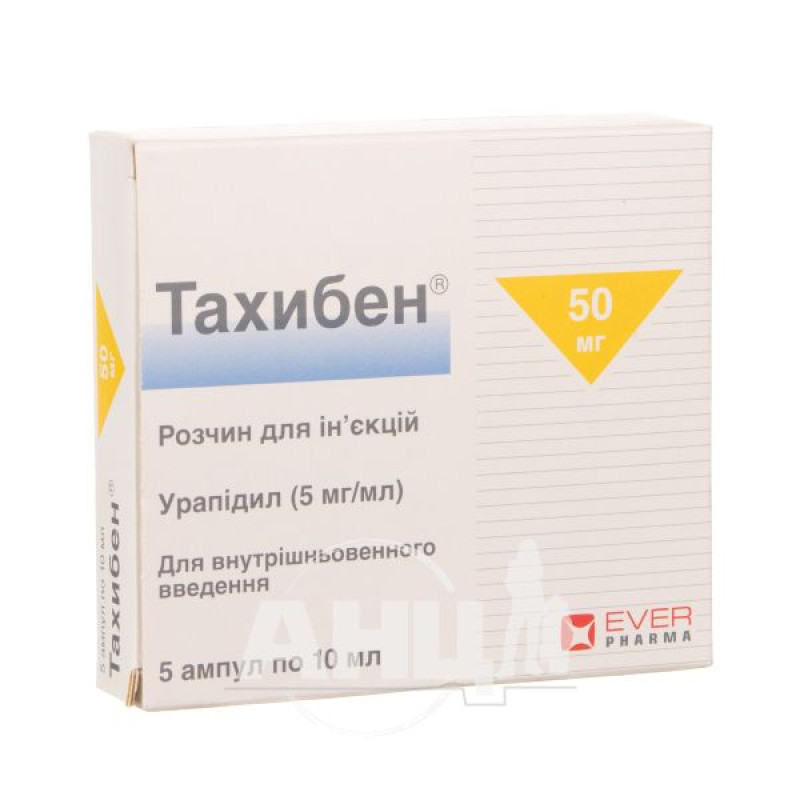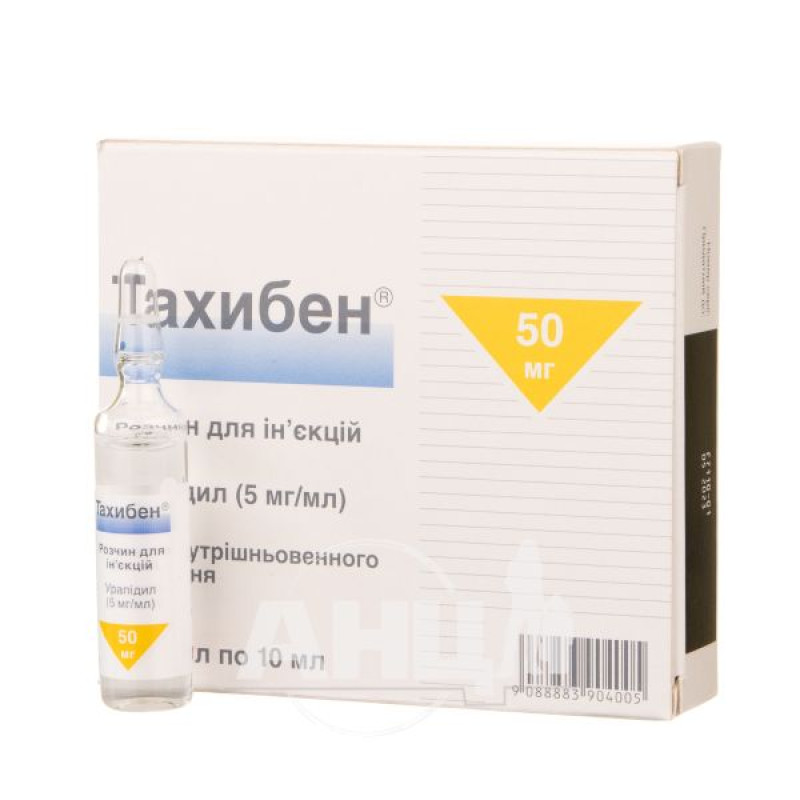Tachiben solution for injection 50 mg ampoule 10 ml No. 5

Pharmacological properties
Pharmacodynamics. Urapidil causes a decrease in systolic and diastolic blood pressure by reducing peripheral vascular resistance. Heart rate is practically unchanged. Cardiac output is unchanged; if cardiac output has been reduced due to increased afterload, it may increase. Urapidil has central and peripheral mechanisms of action.
The peripheral action of urapidil mainly blocks postsynaptic α 1 -adrenoreceptors, thus inhibiting the vasoconstrictor effect of catecholamines.
CNS effects: Urapidil alters the activity of centers in the brain that control blood circulation. As a result, a decrease in the reflex increase in the tone of the sympathetic nervous system or a decrease in the tone of the sympathetic nervous system is noted.
Pharmacokinetics. After administration at a dose of 25 mg, a two-phase decrease in the concentration of urapidil in the blood plasma is noted (first the initial distribution phase, then the terminal elimination phase). The half-life is about 35 minutes, the volume of distribution is 0.8 l/kg (range 0.6-1.2 l/kg).
Urapidil is metabolized in the liver. The main metabolite is a hydroxylated derivative of urapidil at the 4th position of the phenyl ring, which has practically no antihypertensive activity. The O-demethylated metabolite is formed in very small quantities and exhibits approximately the same biological activity as urapidil.
In humans, 50-70% of urapidil and its metabolites are excreted in the urine (about 15% as pharmacologically active urapidil). The remainder is excreted in the feces as metabolites (mainly as inactive parahydroxylated urapidil).
T ½ of urapidil from blood plasma after bolus administration is on average 2.7 h (range 1.8-3.9 h). Binding to human plasma proteins in vitro is 80%. This relatively low degree of binding to plasma proteins explains why there is still no information on the drug interaction of urapidil with other drugs that have a high degree of binding to plasma proteins.
In patients with severe hepatic and/or renal insufficiency, as well as in elderly patients, the volume of distribution and clearance of urapidil are reduced, and T ½ is prolonged.
Urapidil penetrates the blood-brain barrier and the placental barrier.
Indication
Hypertensive crisis, severe forms of hypertension, refractory hypertension, controlled (controlled) reduction of blood pressure when it increases during and/or after surgery.
Application
Hypertensive crisis, severe forms of hypertension, refractory hypertension.
Intravenous injection 10-50 mg of urapidil is administered intravenously slowly with constant monitoring of blood pressure. A decrease in blood pressure can be expected within 5 minutes after injection. Depending on the clinical effect, repeated administration of the drug (at a dose of 10-50 mg of urapidil) is possible.
Intravenous drip infusion or infusions using a perfusion device: to maintain blood pressure at the level achieved by injection, the drug is administered by infusion.
Preparation of solution for infusions
IV drip infusion: 250 mg of urapidil (50 ml of the drug) is added to 500 ml of 0.9% sodium chloride solution for injection or 5% or 10% glucose solution for infusion.
IV infusion using a perfusion device: 100 mg of urapidil (20 ml of the drug) is drawn into the perfusion device and diluted to a volume of 50 ml with 0.9% sodium chloride solution for injection or 5% or 10% glucose solution for infusion.
The drug is diluted under aseptic conditions.
Before administration, the solution should be visually inspected for color and particulate matter. Only clear, colorless solutions that do not contain particulate matter should be used.
The concentration of the infusion solution should not exceed 4 mg urapidil/ml.
The rate of administration is adjusted depending on the individual blood pressure response. The recommended rate of administration is no more than 2 mg/min.
The maintenance dose is an average of 9 mg/h. When diluting 50 ml of the drug (250 mg of urapidil) in 500 ml of solvent, 1 mg = 44 drops = 2.2 ml.
Controlled (controlled) reduction of blood pressure when it increases during and/or after surgery.
dosage regimen
in 2 minutes
infusions
| After 2 minutes, blood pressure does not change⇓ | Initially, the rate of administration is up to 6 mg in 1-2 minutes, then it is lowered | |
| Intravenous injection of 25 mg urapidil (5 ml of the drug) | Blood pressure drops⇒ in 2 minutes | |
| After 2 minutes, blood pressure does not change⇓ | ||
| Slow IV injection of 50 mg urapidil (10 ml of the drug) | Blood pressure drops⇒ in 2 minutes | |
Note: The drug is administered intravenously to patients in the supine position. The dose can be administered by one or more injections or by slow infusion. Injections can be combined with a subsequent slow infusion.
Treatment of elderly patients. In elderly patients, antihypertensive agents should be used with caution and started with low doses, since the sensitivity of such patients to drugs of this pharmacotherapeutic class is often altered.
Treatment of patients with impaired renal and/or hepatic function. It may be necessary to reduce the dose of urapidil for patients with impaired renal and/or hepatic function.
If blood pressure increases again, a course of parenteral therapy may be repeated.
Regular treatment with oral antihypertensive agents can be initiated during a course of emergency parenteral therapy with urapidil.
Contraindication
Hypersensitivity to urapidil or other components of the drug, aortic stenosis, arteriovenous shunts (except for hemodynamically inactive shunts for dialysis).
Side effects
Most side effects are associated with a very rapid decrease in blood pressure. However, clinical experience shows that these effects disappear after a few minutes, even during infusion of the drug, so the decision to suspend therapy should be made depending on the severity of the undesirable effect. Depending on the frequency, adverse reactions are divided into the following categories: very often (≥1 / 10), often (≥1 / 100, 1/10), infrequently (≥1 / 1000, 1/100), rarely (≥1 / 10,000, 1/1000), isolated (1/10,000).
From the blood and lymphatic system: rare - thrombocytopenia.
From the cardiovascular system: infrequently - palpitations, tachycardia, bradycardia, a feeling of pressure or pain behind the sternum (symptoms similar to angina pectoris), difficulty breathing, arrhythmias, orthostatic dysregulation (decrease in blood pressure when changing body position, for example, getting up from a lying position).
Gastrointestinal tract: often - nausea; infrequently - vomiting.
General effects and local reactions: rarely - increased fatigue; isolated - asthenia.
From the nervous system: often - dizziness, headache.
On the part of the psyche: isolated - anxiety.
From the reproductive system and mammary glands: rarely - priapism.
From the respiratory system, chest organs and mediastinum: rarely - nasal congestion.
From the skin and subcutaneous tissue: infrequently - increased sweating; rarely - symptoms of skin allergic reactions (itching, rash, exanthema).
Special instructions
It is necessary to use the drug with caution:
in heart failure caused by mechanical heart dysfunction, such as aortic or mitral valve stenosis, pulmonary embolism or deterioration of cardiac function due to pericardial disease; in patients with impaired liver function; in patients with moderate to severe renal impairment; in elderly patients; with concomitant use of cimetidine (see Interactions with other drugs).If urapidil is not
There are no reviews for this product.
There are no reviews for this product, be the first to leave your review.
No questions about this product, be the first and ask your question.




